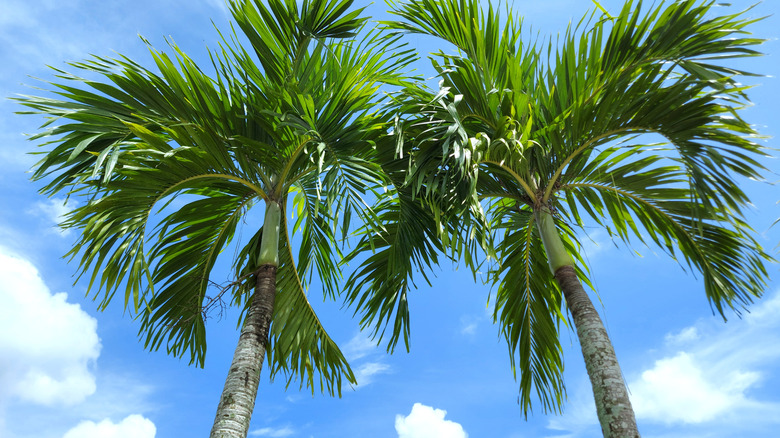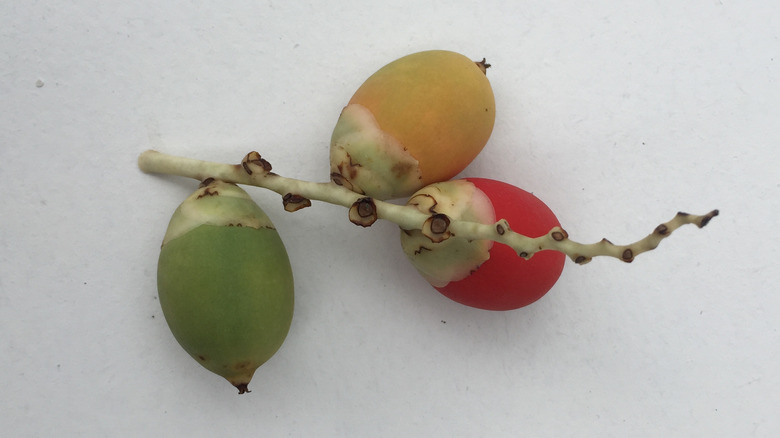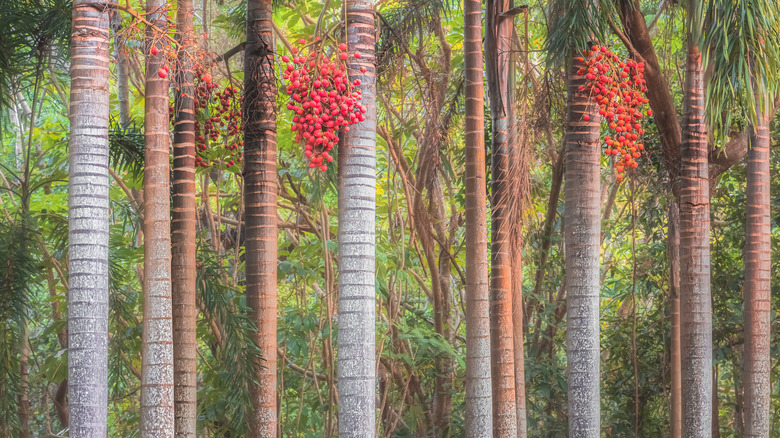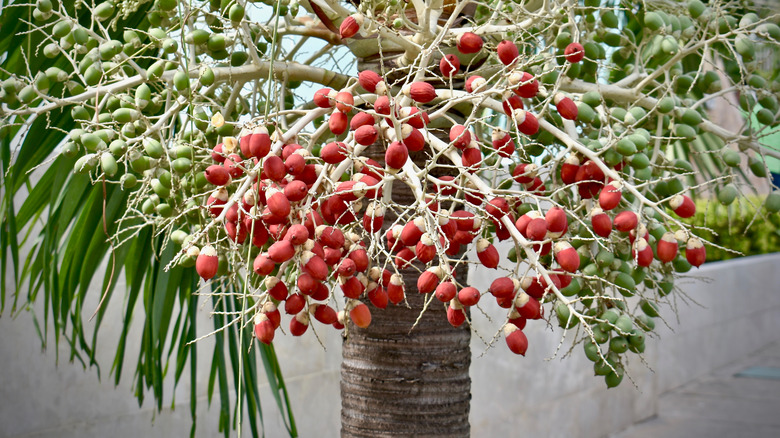How To Grow And Take Care Of A Christmas Palm Tree
The Christmas tree palm is a member of the Arecaceae family, a large group of perennial flowering plants with over 2,600 species. So named for the red bunches of berry-like fruit that ripen in late fall or early winter, this tropical tree will spend the holidays looking as if it's been decked out for Santa and his reindeer with some lights for décor. The scientifically named Adonidia (genus) merrillii (species) is considered a dwarf (and easier to grow) version of the royal palm. This means it grows to a maximum of 25 feet as opposed to the monstrous proportions of its royal cousin, which can grow to 60 feet. In addition, the pinnate, or feather-shaped, fronds of this tree can each get to 5 feet long.
Christmas palms are naturally found swaying in the ocean breezes in South Florida, but they can also make a good-life evoking statement in other temperate zones when potted on a patio for summer and brought inside for the rest of the year. According to Missouri Botanical Garden, these trees also go by the names Manila palm because they are endemic to the Philippines, and Merrill palm, for the American botanist Elmer Drew Merrill who spent much of his career identifying plant species in Southeast Asia.
How to use a Christmas palm tree in garden
Manageable in size and oozing with the relaxed vibe of the tropics, the Christmas palm is commonly planted near patios and pools to conjure that much-desired feeling of paradise. In fact, while there are over 130 species of palm tree within the Arecaceae family, folks at The Spruce place the Christmas palm high on their list of the top 10 yard-friendly varieties.
Since they are tall and thin with bland gray bark up the length of their trunks, a singular Christmas palm does not make the best option for a focal point on its own. Think instead of the 60-foot royal palms lining the boulevards of Southern California as movie stars drive their slick convertibles down the street. You can create that same allure in your yard by planting a few of the smaller Christmas palms in a row. Line a path or frame an entryway to create a strong visual appeal. When used for shade in a yard, these palms are usually planted close together in groups of three. To flush out a landscape, try adding smaller, bushier palms like a pygmy date or a bottle palm.
How to grow a Christmas palm tree
Does the idea of a Christmas palm in your yard have you dying to jazz up your zone 10 or higher garden? Or do you live somewhere cooler but have a bright, warm spot in the house that calls for an eye-catching reminder of the sun-soaked coast? Let's look at what it would take to grow and care for a Christmas palm tree. Per Gardening Know How, germinating seeds collected in late fall is the best option if you can keep your seed trays very warm. First, break open the ripened red fruit, remove the seeds, and wash them in water with a splash of bleach to remove all of the pulp. Next, bury the seeds just a touch, so they're covered with soil but still close to the surface. You may need a greenhouse, space heater, or heating pad to keep your seed trays between 70-100°F. Water regularly, and sprouts will appear in two to three weeks.
Propagating from stem cuttings is possible with palms if you can find new growth near the tree's base. However, this approach is far from a sure thing because these stems are not considered true offshoots and therefore won't always contain enough cell growth or nutrients to survive and mature. Overall, these trees require quite a bit of sun. They can survive in partial shade but will stay thin and flimsy without enough direct sunlight.
How to care for a Christmas palm tree
Planted in the ground in a tropical zone, your Christmas tree palm should be happy on its own with very little necessary maintenance. However, watering will be your number one concern in a more desert-like environment with hot temperatures but low moisture. Per The Spruce, the best fertilizer for these trees is one that contains boron, as this is a deficiency common to palms. No need to worry about how high up in the air the fronds of your palm will be as its trunk reaches to the sky. You won't need to prune them because they will simply fall off once they die.
However, it's important to keep your yard free of fallen fronds, fruit, and other debris. The fruit will rot and attract unwanted bugs. Rotting fruit can also become a breeding ground for pathogens, which can be difficult to eliminate once they stick to leaves. If you prefer to decrease the amount of fallen fruit, you can purchase a pole pruner to cut the stems as they flower. Either way, this clean-up process will make up the bulk of your Christmas palm maintenance routine. Keep in mind that these trees will not live long should the temperature dip below 30°F. So if you choose to keep your tree potted to bring it inside when it gets cold, it will need a sunny and warm spot indoors.
Is the Christmas palm tree toxic?
Because Christmas tree palms are not poisonous to humans or animals, including dogs, cats, and horses, so they make a delightful addition to yards and homes with kids and pets. The fruit of this tree is also considered nontoxic, so while it's certainly not something to be encouraged, you won't need to worry if you find your pooch munching on them. However, with so many varieties of palm trees available, it can be nerve-racking to make sure the one you choose will in no way harm your pet. It's important to keep in mind that the fruit and seeds of a different variety of palm, known as Queen Sago, are highly toxic.
According to VCA Animal Hospitals, animals who consume even a small bite of one of these seeds can show severe symptoms within minutes. Neurological damage may occur, as well as liver impairment, which can lead to issues with blood clotting and both internal and external bleeding. Unfortunately, it is not uncommon for blood loss and shock to result in death. For this reason, if you're unsure exactly which variety of seed or fruit your pet has eaten, never hesitate to call or bring them to a qualified veterinarian for care, especially if they exhibit any signs or symptoms of poisoning. Early intervention is your best shot for ensuring your pet bounces back to full health.
How to repot your Christmas palm tree
Christmas palm trees will grow tall with most of their weight at the very top, so heavy and sturdy pots are required when confining them to containers. The Spruce recommends repotting in spring using clay or sandy soil. And, as is true for most plants, proper drainage holes are key. These palms will tolerate a bit of neglect or drought over standing water any day.
A healthy tree should prove to be a fast grower at first, which will require repotting every year. Nonetheless, according to the University of Florida's IFAS Extension, growth will slow down significantly once a tree reaches 6 feet. After that, it should only require a larger environment every two to three years until it reaches its maximum height. Still, pay attention to its overall growth habits. A tell-tale initial sign of a root-bound plant is slow or complete lack of growth.
Christmas palm berries for nga-nga chewing
Nga-nga is the name for the ancient ritualistic practice of chewing on betel nuts, which is said to produce a euphoric and psychoactive high. Dating back to 6500 B.C. and enjoyed by people of all ages worldwide, nga-nga is described by the Stuart Exchange's Philippine Medicinal Plants list as both culturally significant and medicinally beneficial. It can be encountered in everyday social situations or being served in the formal tea settings of the bourgeoisie. Red teeth, lips, and mouths are common in the Philippines and India, where the pleasure drawn from nga-nga is considered to be on par with perfume, intercourse, indulgent food, and more.
While the betel nut is the preferred main ingredient, the ripe red seeds of the Manila (or Christmas) palm are known to create an effective stimulant substitution, as well as an equally reddened mouth. Often combined with tobacco, which gives it an addictive slant, nga-nga chewing remains popular to this day. When all ingredients are maintained in their natural state, it is also completely legal.






